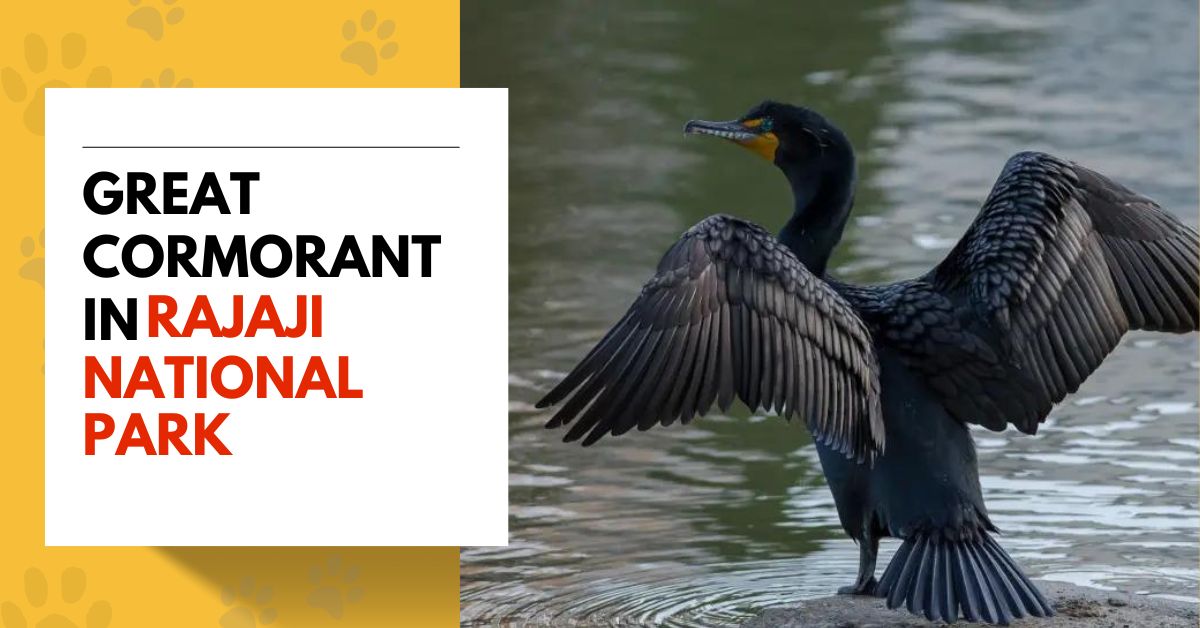Jungle Safari Rajaji National Park, nestled in the lap of the Himalayas in the Indian state of Uttarakhand, is a treasure trove of biodiversity. Among its diverse avian inhabitants, the Great Cormorant (Phalacrocorax carbo), a majestic bird known for its sleek silhouette and exceptional fishing prowess, holds a significant place. This article delves into the intriguing world of the Great Cormorant in Rajaji National Park, exploring its habitat, behavior, ecological significance, and the conservation efforts dedicated to preserving its habitat.
Habitat and Distribution


The Cormorant, a member of the Phalacrocoracidae family, is a widespread bird species found across the globe. In Rajaji National Park, these birds predominantly inhabit the aquatic ecosystems, including rivers, lakes, and marshlands. The park’s rich network of rivers, including the Ganges and its tributaries, provides an ideal habitat for these aquatic birds.
Behavior and Characteristics
Cormorants are known for their distinctive appearance and behavior. With their long necks, hooked bills, and dark plumage, they cut a striking figure against the backdrop of the park’s water bodies. These birds are highly skilled divers, capable of plunging into the water to depths of up to 10 meters in search of prey. Their diet primarily consists of fish, which they catch using their sharp bills and swallow whole.

One of the most fascinating aspects of Great Cormorant behavior is their habit of sunning themselves. After a successful fishing expedition, these birds can often be seen perched on rocks or tree branches with their wings outstretched, basking in the sun. This behavior is essential for regulating their body temperature and drying their feathers, which lack the waterproofing oils found in other bird species.
Ecological Significance
As top predators in their aquatic ecosystems, Cormorants play a crucial role in maintaining ecological balance. By controlling fish populations, they help prevent the overpopulation of certain species, which can have cascading effects on the entire food web. Additionally, their guano (excrement) serves as a valuable nutrient source for aquatic plants and invertebrates, further enriching the ecosystem.
Conservation Challenges

Despite their ecological importance, Cormorants face numerous conservation challenges in Rajaji National Park. Habitat loss and degradation due to human activities such as deforestation, pollution, and encroachment pose significant threats to their survival. Additionally, indiscriminate fishing practices and competition with human fishers for resources further exacerbate their plight.
Conservation Efforts
To address these challenges and ensure the long-term survival of Cormorants in Rajaji National Park, concerted conservation efforts are underway. These efforts include habitat restoration initiatives aimed at preserving and restoring the park’s aquatic ecosystems. Additionally, awareness campaigns are being conducted to educate local communities about the importance of coexisting harmoniously with wildlife.
Furthermore, strict enforcement of wildlife protection laws and regulations is essential to deter illegal activities such as poaching and habitat destruction. Collaborative partnerships between government agencies, non-profit organizations, and local communities are crucial for implementing effective conservation strategies and safeguarding the Great Cormorant’s habitat.

Conclusion
The Great Cormorant is a charismatic and ecologically important bird species that enriches the biodiversity of Rajaji National Park. Through its remarkable adaptations and behaviors, it exemplifies the resilience of nature in the face of anthropogenic pressures. However, concerted efforts are needed to address the conservation challenges facing these magnificent birds and ensure their continued presence in the park’s ecosystems for generations to come. By prioritizing habitat protection, sustainable management practices, and community
FAQs About the Great Cormorant
1. What is the Great Cormorant, and why is it significant in Rajaji National Park?
The Cormorant (Phalacrocorax carbo) is a large aquatic bird species known for its exceptional fishing abilities and distinctive appearance. In Rajaji National Park, these birds play a crucial role in maintaining ecological balance as top predators in the park’s aquatic ecosystems.
2. What does the Great Cormorant look like?
Cormorants have long necks, hooked bills, and dark plumage. They have a sleek silhouette and are often seen perched on rocks or tree branches near water bodies. During the breeding season, adults develop white patches on their cheeks and thighs.
3. Where can I find Great Cormorants in Rajaji National Park?
Great Cormorants primarily inhabit the park’s aquatic ecosystems, including rivers, lakes, and marshlands. They are often spotted near water bodies such as the Ganges and its tributaries, where they hunt for fish.
4. What do Great Cormorants eat?
Great Cormorants primarily feed on fish, which they catch by diving underwater. They are skilled hunters capable of diving to depths of up to 10 meters in search of prey. Occasionally, they may also consume amphibians, crustaceans, and small mammals.
5. Why do Great Cormorants spread their wings out in the sun?
After fishing, Great Cormorants often perch on rocks or tree branches with their wings outstretched, a behavior known as “sunning.” This behavior helps them regulate their body temperature and dry their feathers, which lack waterproofing oils.
6. Are Great Cormorants in Rajaji National Park endangered?
Great Cormorants are not considered endangered globally, but they face conservation challenges in certain regions, including habitat loss and degradation. In Rajaji National Park, efforts are underway to mitigate these threats and ensure the long-term survival of the species.

